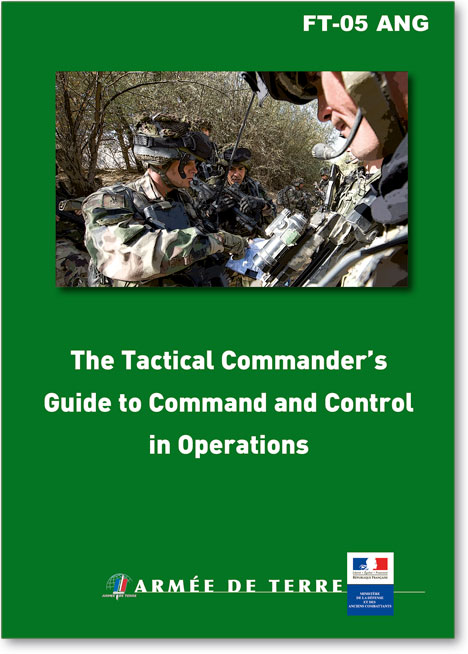December 2011. Backed up by historical examples, it is first and foremost intended to provide food for thought for our officers, in particular the youngest of them, but also for each and every commander who may one day be called upon to exercise command and control in operations.
This doctrinal manual is part of the ongoing series of ‘Capstone Doctrine' documents of the Army's doctrinal corpus. It is also intended to specify the French approach to operational command in the light of the field manuals and handbooks that our key allies have recently published on the same topic.
Read the full document: FT-05 ANG - The tactical commander's guide to command and control in operations

The French version of this doctrinal manual, entitled L'exercice du commandement en operations pour les chefs tactiques and designated FT-05, was approved by the Army Chief of Staff on October 13, 2010, under the reference 1671/DEF/EMAT/ES/B.EMP/ES/10.
Backed up by historical examples, it is first and foremost intended to provide food for thought for our officers, in particular the youngest of them, but also for each and every commander who may one day be called upon to exercise command and control in operations.
This doctrinal manual is part of the ongoing series of ‘Capstone Doctrine' documents of the Army's doctrinal corpus. It is also intended to specify the French approach to operational command in the light of the field manuals and handbooks that our key allies have recently published on the same topic.
The conditions for the use of military force have changed. In today's typical engagements, military action may represent only one line of operations among many others. This evolution is described in the Army's employment of land forces in present and future conflicts Capstone Doctrine Winning the Battle , Building Peace (FT-01). In a context where tactics has regained importance, ground military action now meets three tactical objectives as described in the tactical manual General Tactics (FT-02): force the enemy, control the environment and influence perceptions.
As command and control functions do not change significantly over time, the foundations of command in operations cannot be separated from those in peacetime, and both tend to interact. The question here is not whether to rewrite existing documents or to revisit the foundations and principles of soldiering in the Army that have already been presented in comprehensive and detailed documents . It is, rather, to present in a single doctrinal manual the exercise of command and control in operations for French tactical commanders.
Nevertheless, one should not lose sight of the specificity of command and control in operations which always includes, when appropriate, a choice between tactical effectiveness, or ‘necessary boldness', and fair consideration for the risks in combat, or ‘essential caution'.
Table of contents
PART I. Adapting command and control to the conditions of an engagement to the conditions of an engagement and its strategic objectives
- I.1 The continuum of operations means changing conditions for the exercise of command and control
- I.2 The mission must be firmly defined in a scope concerning all players all players
PART II. Command by objectives through the commander's intent
- II.1 Command and control is not wholly rational but s but still a science
- II.2 Differentiate between the two major styles of command
- II.3 Expressing intent: the best way to reduce uncertainty and promote initiative by subordinates
PART III. applying and combining the six principles of command
- III.1 Simplicity
- III.2 Unity
- III.3 Permanence and continuity
- III.4 Subsidiarity and decentralization
- III.5 Command dialogue
- III.6 Proximity
PART IV. The qualities of the commander
- IV.1 Courage, responsibility and self-confidence
- IV.2 The gift of intuition
- IV.3 The ability to win confidence
- IV.4 An understanding of the general interest
- IV.5 Persuasion and credibility
- IV.6 Discernment
- IV.7 Serenity